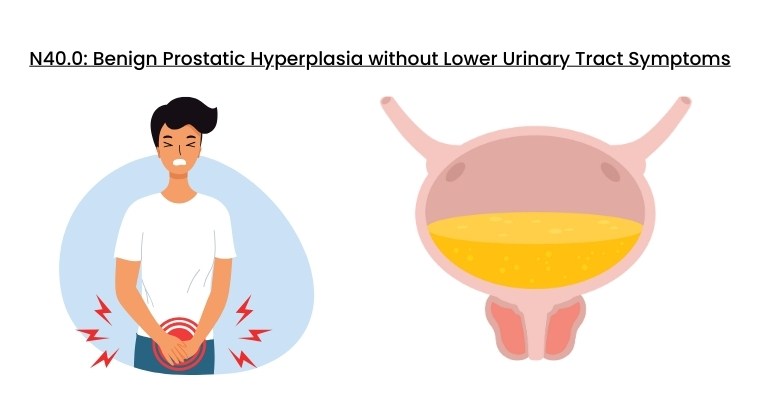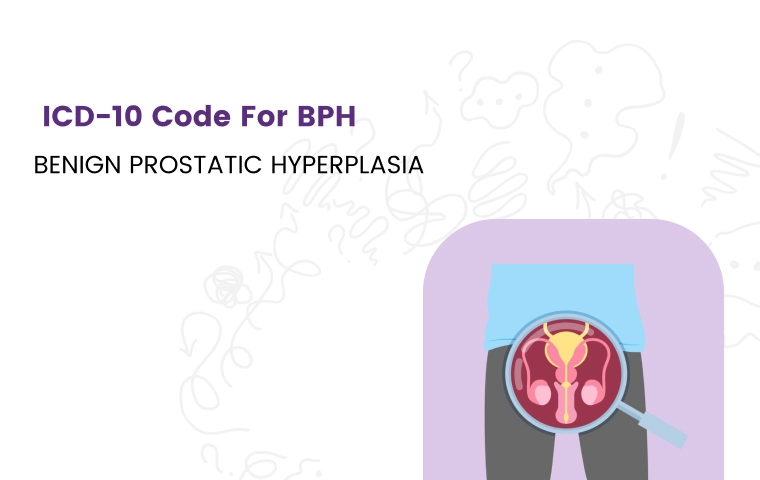Accurate diagnosis coding is paramount for optimal healthcare delivery and reimbursement. However, selecting the right ICD-10 codes for BPH (Benign Prostatic Hyperplasia) can pose a challenge for both clinicians and medical coders.
This comprehensive guide aims to equip healthcare professionals with the knowledge to select the most specific and accurate ICD-10 code for each BPH presentation. We'll explore the specific ICD-10 codes applicable to different BPH scenarios, encompassing the presence or absence of lower urinary tract symptoms (LUTS), laterality, and disease severity.
By understanding the specificities within the BPH coding spectrum, clinicians can ensure proper documentation aligns with the coding requirements, leading to streamlined claims processing and improved financial viability for practices.
What is the Billable ICD-10 Code for BPH (Enlarged Prostate)?
The primary billable ICD-10 code for Benign Prostatic Hyperplasia (BPH), also known as enlarged prostate, belongs to the category N40 - Benign Prostatic Hyperplasia. However, depending on the presence or absence of lower urinary tract symptoms (LUTS), you'll need to choose the most specific code within this category.
ICD 10 Code For BPH With Urinary Obstruction
Lower urinary tract symptoms (LUTS) play a significant role in BPH coding within the ICD-10 system. These symptoms arise due to the enlarged prostate gland obstructing the urethra, the tube that carries urine from the bladder out of the body. Here's a breakdown of how LUTS influence BPH code selection
N40.0: Benign Prostatic Hyperplasia without Lower Urinary Tract Symptoms: This code is used when a patient has an enlarged prostate but doesn't experience any bothersome urinary symptoms.

N40.1: Benign Prostatic Hyperplasia with Lower Urinary Tract Symptoms: This code is the primary choice for most BPH cases where patients experience one or more LUTS such as:

-
Frequency: Frequent urination, including during the night (nocturia)
-
Urgency: A sudden, strong urge to urinate with little time to reach a toilet
-
Hesitancy: Difficulty starting urination
-
Intermittency: A weak or interrupted urinary stream
-
Incomplete emptying: Feeling like the bladder hasn't completely emptied after urination
-
Straining: Difficulty passing urine
ICD-10 Code for BPH, Unspecified
The ICD-10 coding system emphasizes selecting the most specific and accurate code possible to capture a patient's diagnosis. While there might be a temptation to use a generic code like "unspecified" for BPH, it's generally not recommended for the following reasons:
Unspecified codes often lead to lower reimbursement rates compared to more specific codes that accurately reflect the patient's presentation (presence or absence of LUTS).
Unspecified codes don't provide a complete picture of the patient's condition, potentially hindering treatment planning and hindering future data analysis.
Approach BPH Coding When the Information Is Unclear
-
Gather More Information: If documentation lacks details about LUTS presence, consider reviewing patient notes, consulting with the diagnosing physician, or requesting additional information to determine the most accurate code (N40.0 or N40.1).
-
Document Efforts: If gathering further information is not feasible, document your efforts in the medical record. This demonstrates due diligence and can help justify the use of a less specific code if necessary.
Coding Guidelines for BPH
Selecting the most accurate ICD-10 code for Benign Prostatic Hyperplasia (BPH) requires rolling through specific guidelines to ensure proper reimbursement and accurate data collection. Here's a breakdown of key points to remember:
As mentioned earlier, the ICD-10 system emphasizes choosing the most specific code that accurately reflects a patient's BPH presentation. This primarily hinges on the presence or absence of lower urinary tract symptoms (LUTS).
In some BPH cases, the prostate enlargement might be more prominent on one side (unilateral) or both sides (bilateral). While not explicitly included in the main BPH codes, some coding systems allow for additional codes to capture laterality. It's crucial to consult your specific coding resource on the appropriate approach.
While the main BPH codes (N40.0/N40.1) address the core condition, BPH can sometimes present with complications like urinary tract infections (UTIs) or urinary retention. In such cases, additional codes from relevant categories might be needed to capture the complete picture.
Clear communication between clinicians and coders plays a crucial role in accurate BPH coding. Physicians should ensure their clinical notes capture relevant details about LUTS presence/absence and other BPH characteristics. Coders can then utilize these details to select the most specific and accurate code.
Final Words
This resource guide empowers you to choose the most accurate code with laser focus. We've unpacked the key distinctions between N40.0 (BPH without lower urinary tract symptoms) and N40.1 (BPH with symptoms), ensuring you code based on the patient's specific presentation. Laterality and potential complications are also explored, providing a well-rounded understanding of BPH coding.
Remember, clear communication between clinicians and coders is the golden key to accurate documentation. By working together, you can achieve streamlined claims processing and optimal healthcare delivery and contribute to a more efficient healthcare system.
ABOUT AUTHOR

John Wick
As a blog writer with years of experience in the healthcare industry, I have got what it takes to write well-researched content that adds value for the audience. I am a curious individual by nature, driven by passion and I translate that into my writings. I aspire to be among the leading content writers in the world.
